The main points affecting the hands and arms
Shoulder. The place to be struck is the acromial edge of the scapular ridge, the “bone point” of the shoulder. Such a blow can be seen in rugby, usually with a shoulder hit in the area of the solar plexus, the so-called. "Floating edges" (these are the lower 2 pairs of edges), to the groin area.
Armpit. Some wrestling schools use armpits for elbow grips and throws, where the armpit plays the role of a point of support or clamping.
The front of the elbow. This is the surface of the middle part of the ulna, about 3-x inches (7,5 cm) from the tip of the elbow. This hard bone surface is used for a variety of strokes, for example, up the chin, a horizontal blow to the face.
The back of the elbow. This is the back of the humerus, just above the elbow. It is used to strike at the enemy, if he has covered you from behind and your hands are free, along the ribs, over the head. You can also use an elbow strike if the opponent is in front of you.
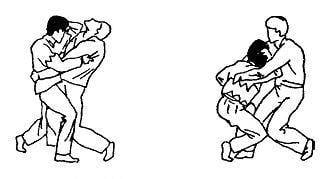
Elbow-ups.
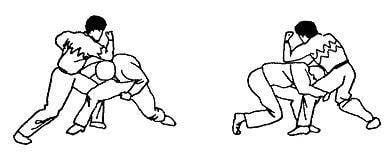
Elbow-top-down.
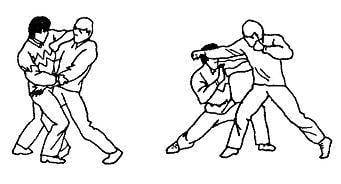
Elbow strikes in and out.
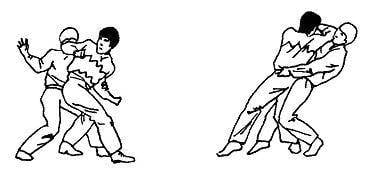
Elbow back-out.
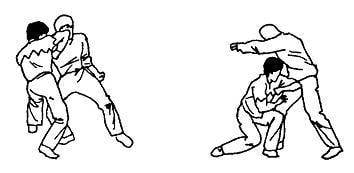
Hitting shots from the inside out.
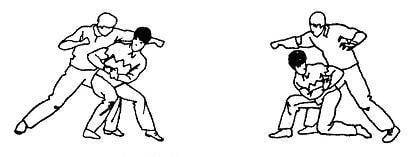
Elbow back.
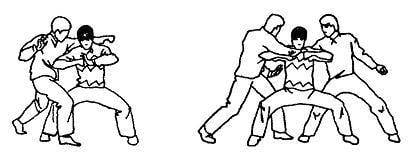
Elbowing to the side.
Fold the elbow. It is actually used not in percussion technology, but for choking, pinching techniques. The most well-known: the girth of the enemy's neck, so that his Adam's needle is on the crook of his arm, in this position the biceps and part of the forearm will press down on the neck arteries, as a result, a person may lose consciousness. The elbow bend is also used to grip the head, the enemy’s head is pressed to its side, and you can beat the enemy or perform other actions.
Nails It is not effective to scratch, it is better to use the nails in order to damage the attacker's eyes, to press on the sore points of the throat.
The tip of the thumb. In principle, it is used, like nails, for pressing on the pain points of an opponent.
The first joint of the thumb. This joint right behind the nail can be used to strike soft tissues.
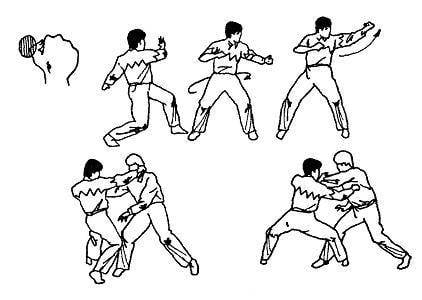
Shock form "knuckle of the thumb."
Big and index fingers. Pinch them can be very painful, and in some areas even hurt a person. For example, the area of the lips and nose, scrotum.
The tip of the index finger. In a number of schools of eastern martial arts teach the technique of attack with one finger. The finger is stretched out and tense, the other three (without a thumb) are squeezed under it, giving it support. Such weapon used for strikes on vulnerable places of a person, pain points, such as the eye, solar plexus, neck. The effectiveness of the attack depends on the degree of preparedness of the fighter and his enemy.
The tips of the index and middle finger. The meaning of the attack, as above, is a blow to the enemy’s vulnerable and painful points.
"Fork" thumb and forefinger. Apply to blows to the throat.
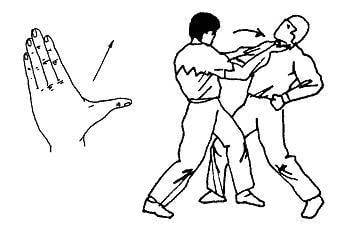
"Fork" fingers.
The tips of the index, middle and ring fingers. This is a classic Oriental piercing hand. The blow is also inflicted on pain points, weak points of the enemy. Usually fingers firmly squeeze, with the middle slightly bent to equalize their different lengths. Another option - three fingers form a kind of triangle, and the middle finger, as it were, “lies” on the shifted index and ring fingers. There are other ways, masters have trained for years to achieve the ability to pierce a person through and through.
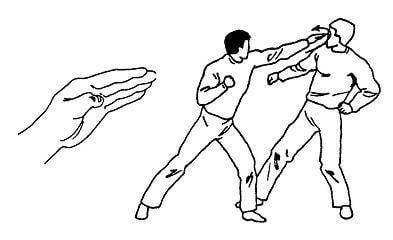
Fingertips.

Finger beak.
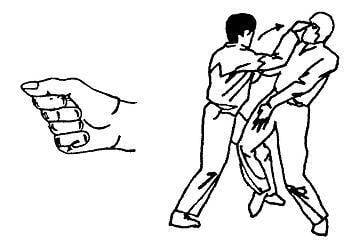
The tip of the thumb.
Knuckle forefinger. When the fingers are clenched into a fist, the knuckle of the index finger forms a tubercle. They can push on the nerve centers, vital points - the temple, neck area, etc.
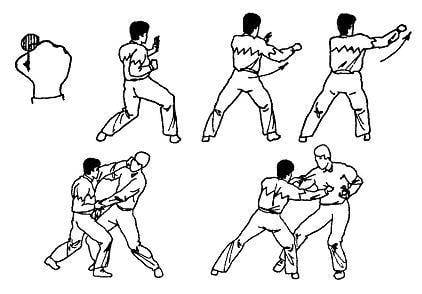
Shock form "knuckle forefinger."
Knuckle middle finger. It is used like the tip of the index finger, but considering that it has more points of support, it is therefore a more accessible weapon for a specially unprepared person.
Knuckles index, middle, ringless fingers and little finger. This is one of the most popular and used human weapons. Of course, it is desirable to strengthen it with regular push-ups on fists, working out percussion equipment on pears and other devices. In eastern styles, including karate, they prefer to beat not all four knuckles, but to concentrate the blow on the knuckles of the index and middle fingers.
The back of the fist. Such punches work out in karate schools.
The bottom of the fist. The part where the little finger is located is often used as an “iron hammer” for striking the enemy.
Palm. In old western films one can quite often see this blow - an open palm, although in appearance it seems to be a frivolous slap or slap. But such a blow will cease to be harmless if it comes to the ear, ears (two palms), nose or groin. It may also be a weapon entirely, for example, to capture the clothes, hair, and wrist of an opponent.
Lower part of the palm. When the wrist is turned back, the lower part of the palm becomes a powerful natural weapon. They can be hit on the face, ribs, solar plexus, in the groin. This part of the arm is less vulnerable than the knuckles.
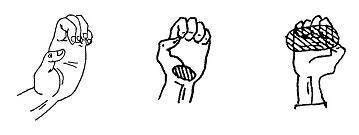
The base of the palm and "claws".
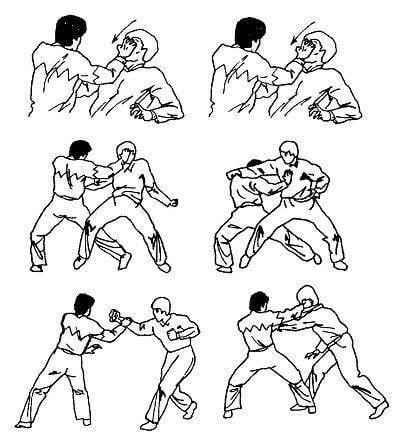
Hitting the base of the palm and "claws".
Back of the palm. The slap in her face is quite painful, and besides that, in karate, she reflects blows.
The edge of the palm of the little finger. One of the most famous techniques of karatekas is a blow by the edge of the palm. The striking surface is the middle part of the fifth metacarpal bone, with adjacent soft tissues. In the use of the "hands-knife" usually do not use the area of the little finger, or the first inch of the palm at the base of the little finger, the main blow falls on the more fleshy two-thirds of the ribs of the palm. Striking slashes to the neck, collarbone, nose, etc.
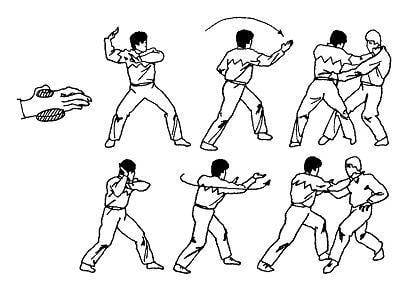
Hit the edge of the palm of the little finger.
The edge of the palm of the index finger. The blow comes from the second, not the fifth metacarpal bone. The palm is opened, the thumb is pressed into the palm, the blow falls on that part of the rib of the palm, where the base of the index finger is located. The goals are the same as when hitting the edge of the palm from the little finger.
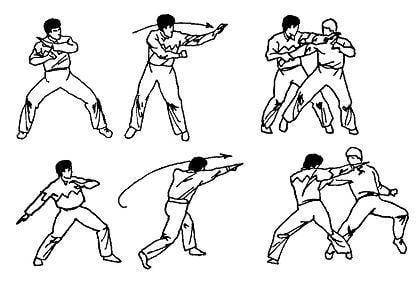
Blow with the edge of the palm from the side of the thumb.
Back of the wrist. If you bend your arm and wrist so that you can try to reach the inside of your wrist with your fingertips, you will find that the back of your wrists will become a hard surface. She can block the blows or even apply them. Especially in the face of the enemy.
Sources of:
Lee B. The way forward fist. Minsk, 1996.
Mashiro N. Black medicine. How to survive in a world of violence. Ekaterinburg, 2006.
Oznobishin N.N. The art of hand-to-hand combat. M., 2005.
http://army.lv/ru/8.-Osnovnie-udari-konechnostyami/2097/3871
Information